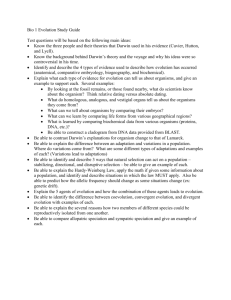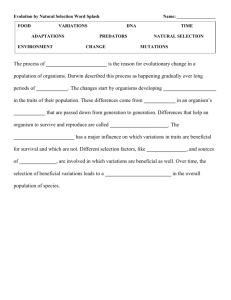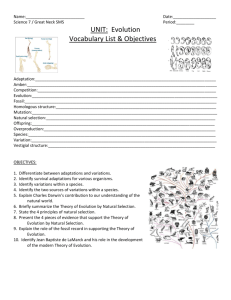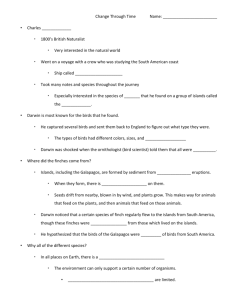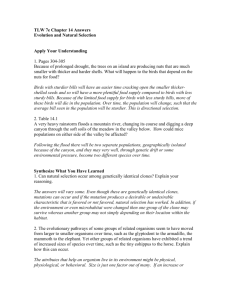Jean Baptist Lamarck vs Charles Darwin theories of Evolution
advertisement
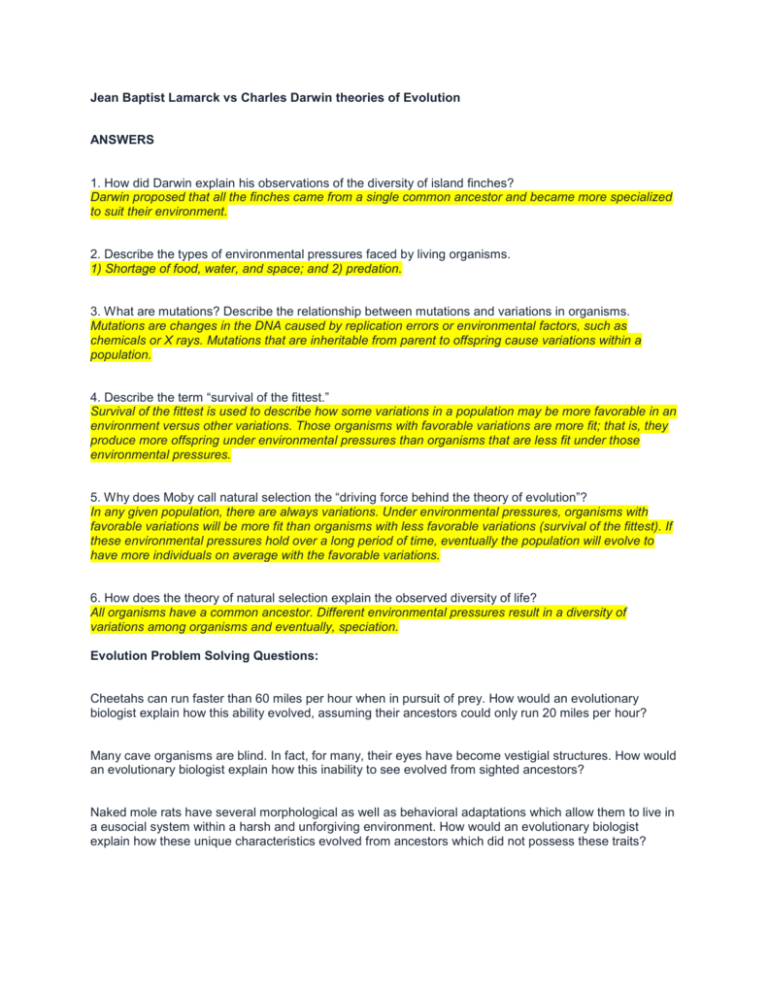
Jean Baptist Lamarck vs Charles Darwin theories of Evolution ANSWERS 1. How did Darwin explain his observations of the diversity of island finches? Darwin proposed that all the finches came from a single common ancestor and became more specialized to suit their environment. 2. Describe the types of environmental pressures faced by living organisms. 1) Shortage of food, water, and space; and 2) predation. 3. What are mutations? Describe the relationship between mutations and variations in organisms. Mutations are changes in the DNA caused by replication errors or environmental factors, such as chemicals or X rays. Mutations that are inheritable from parent to offspring cause variations within a population. 4. Describe the term “survival of the fittest.” Survival of the fittest is used to describe how some variations in a population may be more favorable in an environment versus other variations. Those organisms with favorable variations are more fit; that is, they produce more offspring under environmental pressures than organisms that are less fit under those environmental pressures. 5. Why does Moby call natural selection the “driving force behind the theory of evolution”? In any given population, there are always variations. Under environmental pressures, organisms with favorable variations will be more fit than organisms with less favorable variations (survival of the fittest). If these environmental pressures hold over a long period of time, eventually the population will evolve to have more individuals on average with the favorable variations. 6. How does the theory of natural selection explain the observed diversity of life? All organisms have a common ancestor. Different environmental pressures result in a diversity of variations among organisms and eventually, speciation. Evolution Problem Solving Questions: Cheetahs can run faster than 60 miles per hour when in pursuit of prey. How would an evolutionary biologist explain how this ability evolved, assuming their ancestors could only run 20 miles per hour? Many cave organisms are blind. In fact, for many, their eyes have become vestigial structures. How would an evolutionary biologist explain how this inability to see evolved from sighted ancestors? Naked mole rats have several morphological as well as behavioral adaptations which allow them to live in a eusocial system within a harsh and unforgiving environment. How would an evolutionary biologist explain how these unique characteristics evolved from ancestors which did not possess these traits? (Note: The term eusocial as defined by Krebs and Davies (1993) includes animals that exhibit: 1) cooperative care of the young; 2) a reproductive division of labor - that is, some castes or classes are less fecund or sterile; 3) an overlap of at least two generations; that is, the offspring assist the parents during some period of their life.) Scenario A A change in the environment increased competition between the birds, and resulted in a depletion of the food supply in the shallow waters. This created a need for the short-legged birds to wade into deeper water in order to survive, which forced them to stretch their legs, because they didn’t want to get knocked over by the little waves. This stretching caused their legs to get a little longer. When these birds produced hatchlings, the baby birds grew up with slightly longer legs inherited from their parents. These offspring birds needed to wade out even farther, so they stretched their legs even more, and made them a little bit longer yet. In turn, their hatchlings grew up with even longer legs inherited from their parents, and so on… Eventually, after many generations of this process, the legs of these birds were so much longer than the ancestral birds that the new birds could be described as a new species . Scenario B Within the species of ancestral short-legged shore birds, there is a range of leg lengths, from a bit shorter to a little bit longer than the average leg length. These leg lengths tended to run in the families (i.e., leg length was hereditary). A change in the environment increases competition between the birds, depleting the food supply in the shallow waters. The birds with the slightly longer legs could wade out a little farther. As a result, they obtained more food, lived a little longer, and therefore produced more hatchlings. Those with the shorter legs would tend to starve to death. Since the tendency for leg length was already inheritable, the surviving long-legged birds tended to have more long-legged hatchlings, which likewise tended to get more food and produce more hatchlings and so on… Eventually, after many generations of this process, the average leg length of these birds was so much longer than the ancestral birds that the new birds could be described as a new species. Answer these questions based on the scenarios presented. 1. Which scenario sounds like an explanation that Darwin might give? Why? Scenario B. It contains elements of Darwin’s natural selection process, including: 1) inheritable variations, 2) an environmental change, and 3) survival and reproduction of those with traits enabling survival in the changing environment. No mention of “need” nor individual efforts to make physical changes “in order to survive.” 2. Which scenario sounds like an explanation that Lamarck might give? Why? Scenario A. It contains elements of Lamarck’s hypothesis, including: 1) environmental change creates “need” for individuals to change, 2) by individual effort, physical changes are produced, and 3) newly acquired physical changes somehow become genetic and heritable, and are therefore passed on to offspring. 3. What are the specific clues that most clearly distinguish a Darwinian explanation from a Lamarkian explanation? See answers 1 and 2. 4. Go back to the two scenarios. Underline the specific terms and phrases that distinguish the Lamarkian explanation from the Darwinian one. See underlined terms and phrases in passages. 5. Which explanation is most likely correct given the evidence for Darwin’s and Lamarck’s theories? Darwin’s. Studies based on both hypotheses have repeatedly confirmed Darwin’s hypothesis and refuted Lamarck’s hypothesis (particularly our knowledge of genetics and inheritance of traits). STUDENT QUESTION SHEET - Jean Baptist Lamarck vs Charles Darwin theories of Evolution 1. How did Darwin explain his observations of the diversity of island finches? 2. Describe the types of environmental pressures faced by living organisms. 3. What are mutations? Describe the relationship between mutations and variations in organisms. 4. Describe the term “survival of the fittest.” 5. Why does Moby call natural selection the “driving force behind the theory of evolution”? 6. How does the theory of natural selection explain the observed diversity of life?
